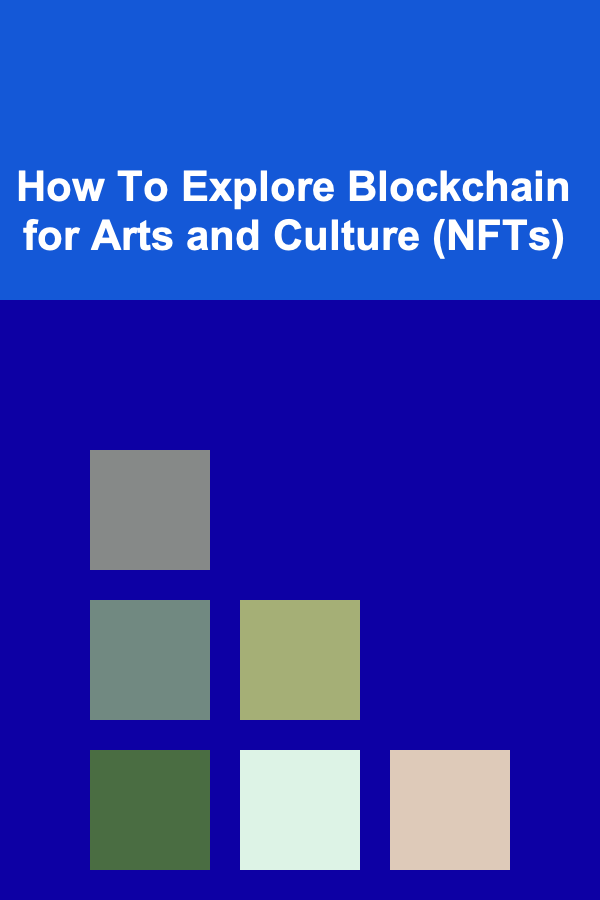
How To Explore Blockchain for Arts and Culture (NFTs)
ebook include PDF & Audio bundle (Micro Guide)
$12.99$5.99
Limited Time Offer! Order within the next:

Blockchain technology has revolutionized numerous industries over the past decade. While its initial claim to fame was as the foundational technology for cryptocurrencies like Bitcoin, its applications have expanded into various sectors, including finance, healthcare, logistics, and entertainment. Among the most transformative developments in the world of digital art and culture is the emergence of Non-Fungible Tokens (NFTs), which are built on blockchain technology.
NFTs have opened new opportunities for artists, collectors, and cultural institutions, providing a means to buy, sell, and trade digital art in ways that were previously not possible. Blockchain's decentralized nature allows for transparent, secure, and immutable ownership records, empowering artists to assert their intellectual property rights and reach a global audience. Moreover, NFTs offer artists a new way to monetize their work through royalties and secondary sales.
In this article, we will explore how blockchain technology is reshaping the arts and culture sector, particularly through NFTs. We will examine how artists can leverage this technology to expand their creative boundaries, the impact of NFTs on the cultural industry, and the potential challenges and future prospects of this new paradigm.
What Is Blockchain Technology?
Blockchain is a distributed ledger technology that allows data to be stored across multiple computers in a network. Unlike traditional databases, which are controlled by a central authority, blockchain operates in a decentralized manner, meaning no single entity has control over the entire system. This ensures greater transparency, security, and immutability of the data stored within the blockchain.
The key features of blockchain technology include:
- Decentralization: Data is distributed across a network of computers (nodes), eliminating the need for intermediaries or central authorities.
- Transparency: Every transaction on the blockchain is visible to all participants, ensuring openness and accountability.
- Security: Transactions are encrypted and recorded in blocks, making it extremely difficult to alter or tamper with data once it has been added to the blockchain.
- Immutability: Once a transaction is recorded on the blockchain, it cannot be changed or deleted, ensuring that records are permanent and trustworthy.
These features make blockchain an ideal technology for digital assets, where ownership, authenticity, and provenance are critical.
Understanding NFTs (Non-Fungible Tokens)
An NFT is a type of digital asset that represents ownership or proof of authenticity of a unique item or piece of content, typically stored on a blockchain. Unlike cryptocurrencies like Bitcoin or Ethereum, which are fungible (meaning one Bitcoin is identical to another), NFTs are unique and cannot be exchanged on a one-to-one basis. Each NFT is associated with a specific piece of content, such as digital art, music, videos, virtual real estate, and more.
The value of an NFT is determined by several factors, including its rarity, demand, and the reputation of the creator. When an artist creates an NFT, they are essentially minting a token that represents their work on the blockchain. This NFT can then be bought, sold, and traded, with the blockchain ensuring that the ownership history and provenance of the digital artwork are transparent and verifiable.
Key features of NFTs include:
- Unique: Each NFT has unique metadata that distinguishes it from other tokens.
- Indivisible: Unlike cryptocurrencies, NFTs cannot be divided into smaller units.
- Verifiable Ownership: The blockchain records the ownership of the NFT, making it easy to trace and verify who owns a particular digital asset.
- Programmable: NFTs can be programmed to include royalties for the creator, ensuring they receive a percentage of future sales or transfers of the NFT.
How Blockchain and NFTs Are Transforming the Art World
The intersection of blockchain technology and NFTs has created a paradigm shift in the way art is created, bought, sold, and experienced. Below are some of the most significant ways that NFTs are transforming the art world.
1. Empowering Artists
Historically, artists have had to rely on galleries, auction houses, or intermediaries to sell their work. These intermediaries often take a significant cut of the sale price, leaving the artist with a fraction of the revenue. Moreover, the process of selling traditional artwork involves a lot of friction, including logistics, shipping, insurance, and authentication.
With NFTs, artists can bypass these intermediaries and sell their work directly to collectors and fans. This creates a more democratic and accessible marketplace, where artists have greater control over their creations and earnings. Additionally, NFTs allow for programmability, meaning that artists can embed royalties into their NFTs, ensuring that they receive a percentage of every resale of their work. This ongoing revenue stream is something that was previously unavailable in the traditional art world.
2. Digital Art as a Valuable Asset
NFTs have elevated digital art to the level of traditional art, allowing digital works to be sold for substantial amounts of money. This has been particularly transformative for digital artists, who have often struggled to gain recognition in the art world due to the intangible nature of their work. By creating an NFT for their digital art, artists can establish ownership and scarcity, two key factors that contribute to an artwork's value.
Notable NFT sales, such as Beeple's "Everydays: The First 5000 Days" auctioned for $69 million, have demonstrated the potential for digital art to achieve significant financial value. NFTs have opened a new avenue for digital artists to showcase their work and reach a global audience, leading to a more inclusive and diverse art market.
3. Ownership and Provenance
One of the most significant benefits of NFTs is the ability to provide verifiable ownership and provenance of digital artwork. Traditionally, digital art could be easily copied and shared, making it difficult to establish ownership and authenticity. NFTs solve this problem by recording each transaction on the blockchain, creating a transparent and immutable record of the artwork's ownership history.
For collectors, this means that they can be confident in the authenticity of their NFT artwork. The blockchain ensures that each NFT has a traceable and verifiable history, making it easier to buy and sell digital art with confidence. Moreover, NFTs can be programmed to include specific terms, such as limited editions or scarcity, further enhancing the value of the asset.
4. New Opportunities for Collectors
NFTs have introduced new ways for art collectors to engage with digital art. Traditionally, collectors would purchase physical artworks that could be displayed in galleries or private collections. With NFTs, collectors can now buy, sell, and trade digital art in a virtual marketplace. This new form of collecting allows for greater flexibility and access to a global market, as NFT art can be bought and sold across borders without the need for physical transportation.
Additionally, collectors can interact with artists and other collectors in online communities, such as virtual galleries or social media platforms, further expanding the way art is shared and experienced.
5. Cultural Institutions and Museums
Cultural institutions and museums are also exploring the potential of NFTs as a way to engage with art and culture in new ways. Some museums are already experimenting with NFTs as a means of acquiring and exhibiting digital art, while others are offering NFTs as a way for visitors to support their collections or participate in virtual exhibitions.
By integrating blockchain technology into their operations, museums can ensure that the provenance and authenticity of digital works are preserved. Moreover, NFTs can serve as a new revenue stream for these institutions, enabling them to monetize their digital assets or offer virtual experiences for a global audience.
How to Explore Blockchain for Arts and Culture (NFTs)
If you're an artist, collector, or cultural institution interested in exploring blockchain and NFTs for the arts and culture sector, there are several steps you can take to get started.
1. Learn About Blockchain and NFTs
Before diving into the world of NFTs, it's essential to have a solid understanding of blockchain technology and how NFTs work. There are numerous online resources, courses, and tutorials that can help you learn the basics of blockchain, how NFTs are created, and how to navigate NFT marketplaces.
Familiarizing yourself with the underlying technology and the principles of decentralization, transparency, and security will help you make informed decisions when creating or purchasing NFTs.
2. Create a Digital Wallet
To buy, sell, or create NFTs, you'll need a digital wallet that supports cryptocurrency transactions. Popular wallets like MetaMask, Trust Wallet, or Coinbase Wallet allow you to store your cryptocurrency and NFTs securely. Once you've set up your wallet, you can connect it to NFT marketplaces where you can start exploring digital art and collecting NFTs.
3. Explore NFT Marketplaces
There are several NFT marketplaces where you can buy, sell, and trade NFTs. Some of the most popular platforms include:
- OpenSea: One of the largest and most well-known NFT marketplaces, OpenSea allows users to buy and sell a wide range of digital assets, including art, music, and virtual real estate.
- Rarible: A decentralized marketplace for digital art, Rarible allows artists to mint their NFTs and sell them directly to collectors.
- Foundation: A curated NFT marketplace that features high-quality digital art from emerging and established artists.
- SuperRare: A platform that specializes in high-end, unique digital art NFTs.
Exploring these platforms will give you an understanding of the market dynamics, the types of digital art being created, and the price ranges for different kinds of NFTs.
4. Minting Your Own NFTs
If you're an artist or creator looking to mint your own NFTs, most NFT marketplaces offer tools that allow you to create and mint your own tokens. Minting an NFT involves uploading your digital art, adding metadata (such as title, description, and tags), and creating a smart contract that records the NFT on the blockchain.
When minting an NFT, you can decide whether to include royalties, set a fixed price, or allow the marketplace to auction the piece. This is an excellent way to showcase your work to a global audience and start monetizing your digital art.
5. Engage with the NFT Community
NFTs are more than just digital assets; they represent a vibrant and growing community of artists, collectors, and enthusiasts. Social media platforms like Twitter, Discord, and Instagram are popular spaces for engaging with the NFT community. Joining these communities can help you network with other artists, gain exposure, and stay up-to-date on trends and developments in the NFT space.
Challenges and Considerations
While blockchain and NFTs offer numerous benefits for artists and collectors, there are also challenges and considerations to keep in mind:
- Environmental Impact: The energy consumption of blockchain networks, particularly proof-of-work blockchains like Ethereum, has raised concerns about their environmental impact. However, alternative blockchains and Ethereum's upcoming transition to proof-of-stake may help reduce this impact.
- Market Volatility: The NFT market is still relatively new and can be volatile. Prices for NFTs can fluctuate dramatically, and there is no guarantee of profitability.
- Intellectual Property: As NFTs represent ownership of digital assets, it's important for creators to ensure they have the legal rights to the content they mint as NFTs. Plagiarism and copyright infringement are concerns in the NFT space.
Conclusion
Blockchain and NFTs are transforming the world of art and culture by providing new ways for artists to monetize their work, collectors to engage with digital art, and cultural institutions to explore innovative forms of expression. By leveraging blockchain technology, NFTs enable transparent, secure, and verifiable ownership of digital assets, creating a more accessible and inclusive art market.
As NFTs continue to evolve, they will likely play an increasingly prominent role in the future of the arts and culture sector, empowering creators and reshaping the way art is consumed, shared, and appreciated. Whether you are an artist, collector, or cultural institution, exploring the potential of blockchain and NFTs offers exciting opportunities to participate in this groundbreaking movement.

How to Provide One-on-One Teaching Services to Students: An Actionable Guide
Read More
How to Style Your Home for the Holidays Without Overspending
Read More
The Art of Cybersecurity Engineering: Building Robust Systems Against Threats
Read More
How to Use Augmented Reality Filters for Marketing
Read More
How To Master Speedrunning Techniques
Read More
How To Leverage Your Skills for Remote Roles
Read MoreOther Products

How to Provide One-on-One Teaching Services to Students: An Actionable Guide
Read More
How to Style Your Home for the Holidays Without Overspending
Read More
The Art of Cybersecurity Engineering: Building Robust Systems Against Threats
Read More
How to Use Augmented Reality Filters for Marketing
Read More
How To Master Speedrunning Techniques
Read More